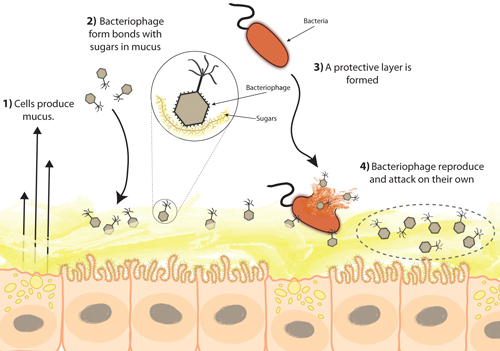New Immune System Discovered
A research team, led by Jeremy Barr, a biology post-doctoral fellow, unveils a new immune system that protects humans and animals from infection.

Mucus may be slimy and gross, but a San Diego State University research team, led by Jeremy Barr, a biology post-doctoral fellow, has discovered that it is also home to a powerful immune system that could change the way doctors treat a number of diseases.
In this previously undocumented immune system, researchers uncovered bacteria-infecting viruses known as bacteriophage, which shield the body from invading infection.
The discovery, made possible with funding from the National Institutes of Health, concentrates on the protective layers of mucus which are present in all humans and animals. It serves both as a home for large populations of beneficial microbes — which can include fungi, bacteria and viruses — and as an entry point for infection.
A new immune system
The researchers sampled mucus from animals and humans — ranging from a sea anemone to a mouse and a person — and found that bacteriophage adheres to the mucus layer on all of them.
They placed bacteriophage on top of a layer of mucus-producing tissue and observed that the bacteriophage formed bonds with sugars within the mucus, causing them to adhere to the surface. They then challenged these mucus cells with E. coli bacteria and found that the bacteriophage attacked and killed off the E. coli in the mucus, effectively forming an anti-microbial barrier on the host that protected it from infection and disease.

Bacteriophage Adherence to Mucus (BAM) model, where bacteriophage adheres to mucus layers and provides immunity against invading bacteria. (Courtesy: Jeremy Barr)
To confirm their discovery, the team also conducted parallel research challenging non-mucus producing cells with both bacteriophage and E. coli. The results — the samples with no mucus had three times more cell death.
“Taking previous research into consideration, we are able to propose the Bacteriophage Adherence to Mucus — or BAM — is a new model of immunity, which emphasizes the important role bacteriophage play in protecting the body from invading pathogens,” Barr said.
A hidden protector
According to Barr, part of what makes this research so novel is that bacteriophage are already present on all humans and animals.
The body recruits the bacteriophage from the environment, which then naturally sticks to mucus layers across various parts of the body including the mouth and gut. The bacteriophage then becomes a protector of its host, accumulating and attacking on its own.
“This discovery not only proposes a new immune system but also demonstrates the first symbiotic relationship between phage and animals,” Barr said. “It will have a significant impact across numerous fields.”
“The research could be applied to any mucosal surface,” Barr said. “We envision BAM influencing the prevention and treatment of mucosal infections seen in the gut and lungs, having applications for phage therapy and even directly interacting with the human immune system.”
About Barr
Barr has been a post-doctoral fellow at SDSU since 2011 and is a part of a team of researchers working in Professor Forest Rohwer’s lab in the Department of Biology. Barr completed his Ph.D. in Brisbane, Australia before beginning his work in Rohwer’s lab investigating mucosal surfaces.
Beginning in July, Barr will be an assistant research professor of biology at SDSU.
Grant and publication details
The research was published in the May Early Edition of the journal Proceedings of the National Academy of Sciences.



